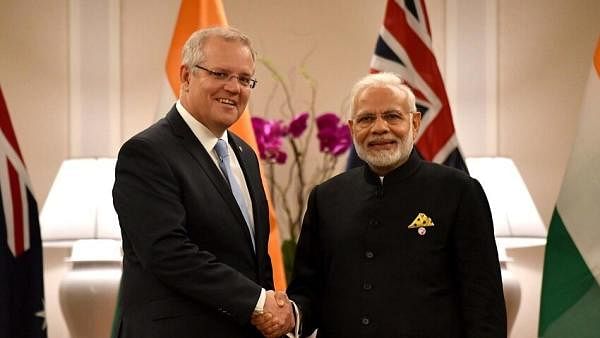
If the primary aim of the first virtual bilateral summit between Prime Minister Narendra Modi and his Australian counterpart Scott Morrison, slated for June 4, is to strengthen the strategic partnership between the two countries, they need to look no further than the higher education sector, where they complement each other.
Almost 10.9 lakh Indian students are pursuing higher education abroad and Australia is the third most popular higher-education destination for international students, hosting at least 3.81 lakh international students.
Direction of diplomacy
Before we delve into the opportunities for India and Australia to strengthen their partnership on the higher education front, let’s look at other key factors playing out in the international scenario.
Miffed with Australia’s call for an independent probe into the origin and spread of COVID-19, China has levied a hefty tariff on barley imports, tweaked rules for delaying iron ore imports and threatened to downsize its trade.
The Chinese Ambassador to Australia opined that its people may not consume Australian wine or beef. He also added: “Maybe the parents of the students would also think whether this place, which they find is not so friendly, even hostile, is the best place to send their children to.” If China sticks to its guns and prevents its students from studying in Australia, then it would certainly imperil the latter’s international higher education exports.
At the other end of the spectrum, India might be at the receiving end of visa restrictions from the US, the top destination for Indian students, though the relationship between the two countries is buoyant. US President Donald Trump has said that to protect jobs for American citizens, he “will be signing an Executive Order to temporarily suspend immigration into the United States.”
The proposed move to restrict immigration, including for education, would require a rejig within the Indian higher-education sector, as it would need to accommodate more students who would otherwise have crossed borders in pursuit of higher education.
Economics of international higher education
Australia would be keen on expanding its export base and reduce its dependence on China, which accounts for over 26 percent of its total trade in 2018-19, as per the Australian Trade and Investment Commission. India is its sixth-largest trading partner, along with New Zealand and the UK, contributing 3.4 percent of its total trade.
According to the Australian Department of Education, international education, of which higher education is the largest component, is its fourth-largest export earning $37.6 bn in 2018-19, coming only behind iron ore, coal, and natural gas exports. Unlike overall trade, international education export is a duel between China and India, the top two sources for Australia, with the former contributing 32 percent and the latter offering 14.6 percent of Australia’s total education export income.
As per the latest statistics, Australia is hosting 1.65 lakh Chinese and 1.05 lakh Indian students. Though the gap between India and China is big, India is contributing increasingly more to Australia’s education export income with an average growth (CAGR) of 27.4 percent, vis-à-vis China’s 19.67 percent, for five years since 2013-14. Importantly, India’s year-on-year contribution zoomed 44.3 percent in 2018-19 compared to China’s 9 percent. Therefore, as things stand, the stage is well set for India to capitalise on its contribution to Australia’s higher education sector.
Australia would be favourable towards accommodating more Indian students, as that would help eliminate or mitigate the loss of export income if Chinese students don’t arrive in the same numbers as before. Even if there is no abatement in the enrolment of Chinese students, it is prudent for Australia to diversify its higher education consumer basket than to rely predominantly on China.
But, why would India send its students overseas, including Australia?
The correlation between education, more specifically higher education, and economic growth is strong. Internationalisation of higher education provides benefits to all the stakeholders, including the host and consuming countries. As internationalising higher education at home requires time, developing countries make use of cross-border higher education, by which its human resources get educated abroad, for a price.
Post their higher education, these skilled human resources help their nation develop when they repatriate as researchers, teachers, entrepreneurs, innovators, etc. Those students who stay back after higher education offer the benefits of diaspora. Further, Indian students are in any case travelling abroad for higher education and are spending an estimated $6-7 bn or Rs 45,000 crore annually, as per a 2015 study.
Win-win solution
It is likely that in a couple of academic seasons, Australia may need more international students to keep its export earnings intact. With depletion in the supply from the US, India may have an oversupply of students who would be keen on travelling abroad for higher education, forcing India to look for a better alternative, which could very well be the UK or Australia. As the UK is relatively more affected by the pandemic, Australia seems to be in the pole position. It would be beneficial for India to send more students to Australia and as a trade-off strategically engage Australia to help internationalise its domestic higher education sector, on favourable terms.
Morrison has termed India as a natural partner and has recently assured that the “Indian community in Australia, including Indian students, would continue to be valued as a vibrant part of the Australian society,” assuaging any misgivings due to the Indian student crisis of 2009. Recently, after speaking with Modi telephonically, he tweeted: “We shared our experiences on managing the crisis and will continue to share knowledge on treatment for the virus and as we work towards a vaccine.” With universities spearheading research and development of vaccines, it’s hoped that both leaders will hit it off well and use higher education for deepening strategic ties.
(M Saravanan is a higher education consultant based in New Delhi. Views are personal)
Disclaimer: The views expressed above are the author's own. They do not necessarily reflect the views of DH.